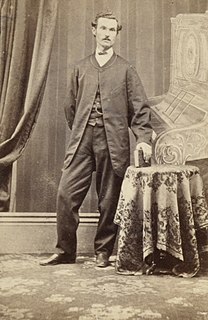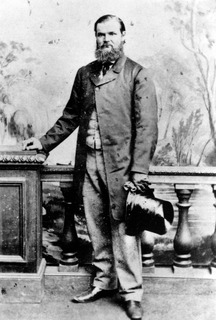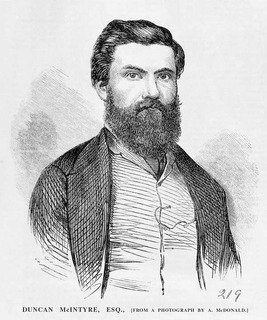Related Research Articles

The Burke and Wills expedition was organised by the Royal Society of Victoria in Australia in 1860–61. It consisted of 19 men led by Robert O'Hara Burke and William John Wills, with the objective of crossing Australia from Melbourne in the south, to the Gulf of Carpentaria in the north, a distance of around 3,250 kilometres. At that time most of the inland of Australia had not been explored by non-Indigenous people and was largely unknown to the European settlers.

Robert O'Hara Burke was an Irish soldier and police officer who achieved fame as an Australian explorer. He was the leader of the ill-fated Burke and Wills expedition, which was the first expedition to cross Australia from south to north, finding a route across the continent from the settled areas of Victoria to the Gulf of Carpentaria. The expedition party was well equipped, but Burke was not experienced in bushcraft. A Royal Commission report conducted upon the failure of the expedition was a censure of Burke's judgement.

William John Wills was a British surveyor who also trained as a surgeon. Wills achieved fame as the second-in-command of the ill-fated Burke and Wills expedition, which was the first expedition to cross Australia from south to north, finding a route across the continent from the settled areas of Victoria to the Gulf of Carpentaria.

Sir John Campbell Longstaff was an Australian painter, war artist and a five-time winner of the Archibald Prize. He was a cousin of Will Longstaff, also a painter, as well as a war artist.

John King was an Irish soldier who achieved fame as an Australian explorer. He was the sole survivor of the four men from the ill-fated Burke and Wills expedition who reached the Gulf of Carpentaria. The expedition was the first to cross Australia from south to north, finding a route across the continent from Melbourne in Victoria to the Gulf of Carpentaria in Queensland.

Alfred William Howitt, , also known by author abbreviation A.W. Howitt, was an Australian anthropologist, explorer and naturalist. He was known for leading the Victorian Relief Expedition, which set out to establish the fate of the ill-fated Burke and Wills expedition.

Innamincka, formerly Hopetoun, is a town and locality in north-east South Australia, with a population of 44 people. It is 821 kilometres north-east of Adelaide and 365 kilometres north-east from the closest town, Lyndhurst. It is also 66 kilometres north-east of the Moomba Gas Refinery. The town lies within the Innamincka Regional Reserve and is surrounded by the Strzlecki Desert to the south and the Sturt Stony Desert to the north. The township is situated along the Cooper Creek, a part of the Lake Eyre Basin.

William Landsborough was an explorer of Australia and notably he was the first explorer to complete a North-to-South crossing of Australia. He was a member of the Queensland Legislative Council.

John McKinlay, was a Scottish-born Australian explorer and cattle grazier, and leader of the South Australian Burke Relief Expedition - one of the search parties for the Burke and Wills expedition. McKinlay was also a member of Charles Sturt's Central Exploring Expedition from 1844-1845. The town of McKinlay in north western Queensland is named after him.

Ludwig Becker was a German artist, explorer and naturalist. He was born in Rödelheim near Frankfurt am Main. He moved to Australia in 1850, and was a member of the ill-fated Burke and Wills expedition. He died at the expedition's camp on the western bank of Koorliatto Waterhole, Bulloo River in 1861.

Duncan McIntyre was an Australian explorer who followed in the tracks of Burke and Wills. In 1864 he laid claim to the property now called Dalgonally in North-West Queensland, and found evidence of Ludwig Leichhardt's final expedition. He subsequently led a party in search of Leichhardt, but died of fever during the search.

William Oswald Hodgkinson (1835–1900) was an Australian explorer, journalist, gold miner, and politician.

Burke and Wills Plant Camp is a heritage-listed campsite near Betoota within the locality of Birdsville, Shire of Diamantina, Queensland, Australia. It is also known as Return Camp 46 and Burke and Wills Camp R46. It was added to the Queensland Heritage Register on 11 December 2008.

Burke and Wills Camp B/CXIX is a heritage-listed campsite at Burke and Wills Access Road, Normanton, Shire of Carpentaria, Queensland, Australia. It is also known as Walker's Camp. It was added to the Queensland Heritage Register on 14 August 2008.

Dr Ludwig Becker's Grave is a heritage-listed grave at Molesworth Station, by the Bulloo River, Bulloo Downs, Shire of Bulloo, Queensland, Australia. He was buried in 1861. It was added to the Queensland Heritage Register on 5 August 1994.

Burke and Wills Dig Tree is a heritage-listed, blazed, eucalyptus tree at Nappa Merrie Station, Durham, Shire of Bulloo, Queensland, Australia. It was blazed on 21 April 1861. It was added to the Queensland Heritage Register on 28 February 2003.

The Wilson River, part of the Lake Eyre Basin, is an ephemeral river located in the Channel Country in western Queensland, Australia.
Dick of the Barkinji people, also known as Mountain, was an Australian explorer who was on the Burke and Wills support expedition.
Alexander MacPherson was on the Burke and Wills expedition support expedition from the Murray River to Coopers Creek, in September 1860.

The Burke, Wills, King and Yandruwandha National Heritage Place is a heritage-listed historic precinct on the Birdsville Track, Innamincka, South Australia, Australia. It was added to the Australian National Heritage List on 22 January 2016.
References
- ↑ Hermann Beckler, edited by Stephen Jefferies, A Journey To Cooper's Creek (Carlton, Vic., Melbourne University Press, 1993).
- ↑ Peter FitzSimons, Burke and Wills (Hachette Australia )
- ↑ Ian Clark, Fred Cahir, The Aboriginal Story of Burke and Wills: Forgotten Narratives (Csiro Publishing, 2013) page 7.
- ↑ Dig, the Burke and wills Research Gateway.
- ↑ Myles Archibald Lyons,burkeandwills.net.au.